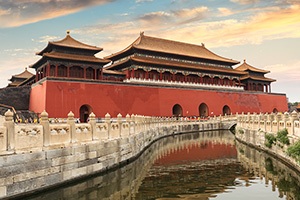
Only 6,000 people over two nights will be allowed into the UNESCO World Heritage site for a light show to mark the Lantern Festival, signaling the end of the Chinese New Year holiday.
Those lucky visitors may be able to discover whether there is any truth to the legend that the Forbidden City, which was the home of China's emperors between 1420 and 1912, is haunted by ghosts who come out only at night.
Usually only VIPs - such as President Donald Trump in 2017 - get to venture into the Forbidden City at night.
The 3,000 people who will visit Tuesday night will include 2,500 invited guests - model workers, couriers, sanitation workers, officers, soldiers and ambassadors - along with 500 people who booked their tickets online. On Wednesday night, a lucky 3,000 who nabbed tickets online will be allowed in.
"The 3,000 visitors can show off for the whole year," quipped one person on Weibo, the Chinese version of Twitter, using the online name of "One Medical Student."
The tickets, which were offered for free, were snapped up within seconds of becoming available online Sunday. Then the website collapsed under the strain. A vibrant secondary market soon emerged. Scalpers were selling tickets for as much as 9,999 Chinese yuan - almost $1,500 - on online trading sites.
Those who get in will see the palace walls illuminated by red lanterns - aiming to give visitors a feel of what it was like to usher in the new year in the royal court some 200 years ago, according to the state-run Xinhua news agency.
They will also see a light show that will include a projection onto a palace roof of a long scroll titled "A Thousand Li of Rivers and Mountains," the only surviving work of Song Dynasty painter Wang Ximeng.
People who climbed up a hill in the park behind the Palace Museum uploaded spectacular photos to social media.
The China National Traditional Orchestra and Chinese opera singers will accompany the light show.
The Forbidden City was home to emperors through the Ming and the Qing dynasties, until China's last emperor abdicated in 1912. It was converted into the Palace Museum in 1925.
The festival is part of an effort by Shan Jixiang, the Palace Museum curator, to make traditional Chinese culture more accessible to the general public.
The number of visitors entering the palace complex this year has increased 70 percent from 2018 levels as the museum has promoted its "Celebrating the Spring Festival in the Forbidden City" exhibition.
More than 80 percent of the palace is now accessible to visitors, up from 30 percent in 2012. Shan has set a target of 85 percent by 2020, to mark the palace's 600th anniversary.
This could be seen as part of a broader political effort in China to stoke nationalist sentiment.
"Creativity makes the 600-year-old Palace Museum younger and draws traditional culture closer to the public," said the People's Daily, the newspaper of the Chinese Communist Party. .
Chinese state television has been running documentaries about the people whose job it is to restore cultural relics inside the Forbidden City, and about the treasures contained within and their role in China's social development. The success of the Palace Museum provides a template for other museums, said Liu Zheng, a member of the Beijing-based China Cultural Relics Academy. They can learn how to make their collections resonate with the public and allow more people to learn about culture and history, Liu told the nationalist Global Times.
A new part of the sprawling Forbidden City will be opened next year, allowing access to the Qianlong Garden, a complex covering two acres that the fifth emperor of the Qing Dynasty built between 1771 and 1776 as his retirement home.
The complex includes 27 extravagantly designed buildings, four courtyards and elaborate rockery gardens. In a helpful act of imperial haughtiness, Qianlong - who reigned from 1735 to 1796, making him the longest-serving ruler in China - issued an order prohibiting future emperors from touching the complex.
That means the buildings have never been changed. Over the past decade, they have been restored by the World's Monuments Fund in partnership with the Palace Museum.
The restoration of a building known as Studio of Exhaustion from Diligent Service, which has silk trompe l'oeil paintings on the ceiling, and jade inlays and bamboo skin carvings in its reception room - was completed in 2008. Work on buildings called the Lodge of Bamboo Fragrance and the Bower of Purest Jade were finished in 2016.
"The buildings contain decoration and furnishings from a time widely considered to be one of the boldest and most extravagant periods of interior design in China's history," the fund said when announcing the effort. "The structures possess some of the most significant, exquisitely designed interiors to survive relatively unchanged from imperial China."
Because the garden was largely abandoned after the last emperor left the Forbidden City in 1924, the 18th-century interiors have survived relatively unaltered from the time they were constructed more than 230 years ago, the fund said.


 Contact The Editor
Contact The Editor
 Articles By This Author
Articles By This Author